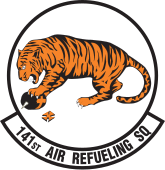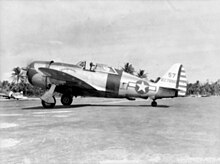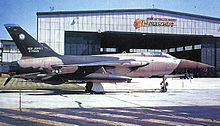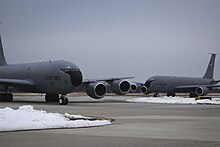This article has multiple issues. Please help improve it or discuss these issues on the talk page. (Learn how and when to remove these messages)
|
141st Air Refueling Squadron
 | |
|---|---|
 141st Air Refueling Squadron Boeing KC-46A Pegasus 141st Air Refueling Squadron Boeing KC-46A Pegasus | |
| Active | 1918–1919; 1942–1946; 1949–1952; 1952–1973; 1973–present |
| Country | |
| Branch | |
| Type | Squadron |
| Role | Air refueling |
| Part of | New Jersey Air National Guard |
| Garrison/HQ | Joint Base McGuire-Dix-Lakehurst, New Jersey. |
| Equipment | Boeing KC-46A Pegasus |
| Insignia | |
| 141st Air Refueling Squadron emblem |  |
| 341st Fighter Squadron emblem |  |
| Tail code (TAC era) | NJ |
| Tail stripe (AMC era) | "New Jersey" Orange tail stripe |
The 141st Air Refueling Squadron (141 ARS) is a unit of the New Jersey Air National Guard 108th Wing located at McGuire Air Force Base, New Jersey. The 141st is currently an "embedded classic associate" with the 305th Air Mobility Wing, flying the Boeing KC-46A Pegasus since 2023.
The 141st was first organized as the 141st Aero Squadron on 2 January 1918 at Rockwell Field, California. The squadron deployed to France and fought on the Western Front during World War I as a pursuit squadron as part of the American Expeditionary Forces. The unit was demobilized after the war in 1919. The 141st has hereditary ties to the 341st Fighter Squadron, which fought in the Pacific Theater during World War II.
During the Cold War, the 141st was a fighter squadron, operating aircraft including the North American F-86E Sabre, Republic F-105B Thunderchief and McDonnell Douglas F-4E Phantom II.
History
141st Aero Squadron
| 141st Aero Squadron | |
|---|---|
| Commanders | Capt. Hobard (Hobie) A. E. Baker |
| Operations |
4th Pursuit Group Western Front, France: 18 October-11 November 1918 |
| Victories | First combat on 28 October 1918, 2 Enemy Aircraft shot down. 1 by Capt. Baker on 28 October; 1 on 5 November, shared by Capt Baker and Lts. Shelby, Cady, Hamlin and Chappell. |
The 141st Aero Squadron (Pursuit) was a United States Army Air Service pursuit squadron, and part of the American Expeditionary Force. It was assigned to the 4th Pursuit Group, Second United States Army, AEF near the end of World War I.
The squadron saw limited combat, and with Second Army's planned offensive drive on Metz cancelled due to the 1918 Armistice with Germany, the squadron was assigned to the United States Third Army as part of the Occupation of the Rhineland in Germany. It returned to the United States in July 1919.
Organization
The squadron was organized at Rockwell Field, San Diego, California, on 8 October 1917. It was organized as an un-designated provisional unit with men drawn from the 14th and 18th Training Squadrons already at the field. The squadron trained with Curtiss JN-4 Jennies at Rockwell Field. It was not until the latter part of December that the mechanics and support enlisted personnel were assigned to the squadron, and was given its formal designation as the 141st on 2 January 1918, when it was ordered to proceed to Garden City, New York, for overseas deployment.
The 141st reached Field No. 2, near Garden City on 9 January, where final preparations for the squadron were made for overseas shipment. On 15 January it moved to Pier No. 45, Hoboken, New Jersey, where it boarded the Cunard liner RMS Carpathia, arriving at Halifax, Nova Scotia, awaiting to form up into a convoy. on the 19th, it began the overseas journey with seven other ships along with the cruiser USS San Diego, arriving at Glasgow, Scotland on 30 January. On the 31st, after a train trip to Winchester, England, the squadron was assigned to the Morn Hill Rest Camp for classification and advanced training in England.
Training in England
For the next several months, the squadron went through advanced training to prepare it for combat at the front in France. "A" Flight was assigned to Dover, Kent; "B" Flight at the Hounslow Heath Aerodrome, near London, and "C" Flight to Northolt Airdrome, also near London. On 9 March 1918, the squadron reformed at Northolt, where it proceeded to the Swingate Down Airdrome, near Dover, Kent where it received final training by the Royal Flying Corps.
The squadron arrived in France on 16 August 1918 and moved to the St. Maixent Aerodrome for equipping. Orders to move were received on 27 August for the Air Service Production Center No. 2 at Romorantin Aerodrome, where it waited for another nineteen days. Finally on 16 September it moved again to the 1st Air Depot at Colombey-les-Belles Airdrome where the 141st received SPAD XIII pursuit aircraft. There it was assigned to the 4th Pursuit Group, and moved to Croix de Metz Aerodrome (Toul) for combat duty, arriving on 19 October.
Meuse-Argonne Offensive

The squadron's insignia was an orange and black tiger with a flyer's helmet. The 141st flew its first patrol on 23 October and every day thereafter. Its combat commander, Hobey Baker, was a famous hockey and football star at Princeton before the war. It was said, Hobey preferred Ivy League men in his unit, preferably from Princeton. Indeed, he painted the aircraft in his squadron in Princeton colors: Orange and Black.
The 141st shot down its first enemy aircraft on 28 October, by Captain Baker. A second enemy aircraft was shot down on 6 November by a patrol consisting of Captain Baker and Lieutenants Shelby, Cady, Hamiln and Chappell. The 141st was involved in 13 combats, the only pursuit squadron of the Air Service, Second Army to do so.
After the November 1918 Armistice with Germany, the squadron remained at Gengault Aerodrome. Tragically, its commander, Captain Hobey Baker was killed on 21 December 1918 when he took a SPAD XIII up for one last ride. The SPAD developed engine trouble while taking off and Baker died when the aircraft crashed soon thereafter.
Third Army of Occupation
On 19 April 1919, the squadron was assigned to the Third Army Air Service, 5th Pursuit Group. It was moved to Coblenz Airdrome, Germany, to serve as part of the occupation force of the Rhineland. For the next several months the squadron was able to perform test flights on surrendered German aircraft. Flights of the Fokker D.VII, Pfalz D.XII, Halberstadts and Rumpler aircraft were made and evaluations were made.
Demobilization
On 18 June 1919, orders were received from Third Army for the squadron to report to the 1st Air Depot, Colombey-les-Belles Airdrome to turn in all of its supplies and equipment and was relieved from duty with the AEF. The squadron's SPAD aircraft were delivered to the Air Service American Air Service Acceptance Park No. 1 at Orly Aerodrome to be returned to the French. There practically all of the pilots and observers were detached from the squadron.
Personnel at Colombey were subsequently assigned to the Commanding General, Services of Supply and ordered to report to one of several staging camps in France. There, personnel awaited scheduling to report to one of the Base Ports in France for transport to the United States. Upon return to the US, most squadron personnel were demobilized at Camp Mills, New York on 18 July 1919.
Reconstitution
On 8 September 1973 By order of the Secretary of the Air Force, the 141st Aero Squadron (Pursuit), demobilized on 19 July 1919 was reconstituted and allotted to the State of New Jersey. It was ordered consolidated with the 141st Tactical Fighter Squadron. The consolidated unit was designated as the 141st Tactical Fighter Squadron and was extended federal recognition by the National Guard Bureau same date. The consolidated unit was also bestowed the lineage, history, honors, and colors of the 141st Aero Squadron (Pursuit).
World War II

- see: 348th Fighter Group for full World War II history
The 341st Fighter Squadron was activated at Mitchel Field, New York, on 30 September 1942. It was equipped with the Republic P-47 Thunderbolt. The 341st was one of the first USAAF squadrons to be equipped with the P-47.
After an extended period of training in the northeast United States, the squadron deployed to Archer Field (Archerfield Airport), Brisbane, Australia in June 1943. Began long-range missions to strike at Japanese targets in New Guinea. In mid-June the 341st made the 1,200-mile flight from Brisbane to Port Moresby, New Guinea. The unit operated from New Guinea and Noemfoor until November 1944, flying patrol and reconnaissance missions and escorted bombers to targets in New Guinea and New Britain.
In 1944 the 341st began to attack airfields, installations, and shipping in western New Guinea, Ceram, and Halmahera to aid in neutralizing those areas preparatory to the US invasion of the Philippines. When U.S. troops landed on Luzon the squadron in process of conversion from P-47's to P-51 Mustangs, began operation from San Marcelino airstrip a few days after the landing at San Marcelino and Subic Bay. From this location the unit engaged in ground support operations, bombing and strafing in close support of ground troops. Remained in the Philippines throughout the campaign, moving to Okinawa in mid July 1945 in preparation for the planned invasion of Japan. Engaged in long-range operations over the Japanese Home Islands until ceasing combat on 14 August 1945.
Became part of the Army of Occupation in Japan, moving to Itami Airfield, Japan in October 1945 as part of Far East Air Forces. Inactivated at Itami Airfield on 10 May 1946.
New Jersey Air National Guard
Cold War
The wartime 341st Fighter Squadron was redesignated the 141st Fighter Squadron, and was allotted to the New Jersey National Guard, on 24 May 1946. It was organized and redesignated as the 141st Strategic Fighter Squadron at Mercer Airport, Trenton, New Jersey and was extended federal recognition on 26 May 1949. The 141st Strategic Fighter Squadron was entitled to the history, honors, and colors of the 341st. The squadron was equipped with F-47D Thunderbolts and was assigned to the 108th Strategic Fighter Group.
In the late 1940s, the new Strategic Air Command (SAC) was manned by personnel of the wartime Eighth and Fifteenth Air Forces. During World War II they usually encountered swarms of enemy fighters and knew the importance of having fighter escorts. In the postwar era, SAC had fighter wings placed under their own operational control. The squadron trained in escorting SAC's B-29 and later B-50 and B-36 strategic bombers.
The unit was called to active federal service on 1 March 1951. The squadron was sent to Turner Air Force Base, Georgia where it continued its mission to provide fighter escorts to SAC bombers on training missions. In December 1951 it moved to Godman Air Force Base, Kentucky where it replaced a unit deployed to England. It was released from active duty and returned to New Jersey state control on 10 November 1952.

With return to state control, the parent 108th Wing was transferred to Air Defense Command (ADC) and was redesignated as a Fighter-Interceptor Wing. The 141st Fighter-Interceptor Squadron was re-equipped with the long-range North American P-51H Mustang fighter. Designed for the invasion of Japan, the P-51H was the last variant of the P-51 Mustang of World War II, but was produced too late to see any wartime combat. Not used in the Korean War due to it not being believed as "rugged" as its famous "D" model predecessor, the P-51H was used instead to equip Air National Guard units into the 1950s as an ADC interceptor. In 1955, the Mustangs were retired and the squadron entered the jet age, with the arrival of the North American F-86E Sabre.
The parent 108th FIW was transferred to Tactical Air Command (TAC) in 1958, being re-designated as a Tactical Fighter Wing. The 141st Tactical Fighter Squadron transferred its interceptors and received and Republic F-84F Thunderstreak fighter-bombers.

At the height of the Cold War in 1961, the squadron was again federalized as a result of tensions concerning the Berlin Wall. 28 F-84F's of the 141st and officers and airmen from all three squadrons of the 108th Wing were deployed to Chaumont-Semoutiers Air Base, France on 16 October with the last aircraft and personnel arriving on 6 November. The ground units deployed by sealift, with the deployed elements reaching Chaumont by 17 November. In France, the deployed elements were assigned to the Provisional United States Air Forces Europe 7108th Tactical Wing on 20 November due to the reduced strength of the 108th Wing in Europe. The primary mission of the 7108th was to provide close air support to the Seventh Army in Europe under the direction of ground forward air controllers. To accomplish this mission, up to 30 sorties were flown each day. The deployment to France ended in October 1962 and the unit returned to New Jersey state control, leaving the F-84Fs in France.

Upon return from France, the squadron was moved from Trenton to McGuire Air Force Base due to air congestion in the Philadelphia area. At McGuire, the squadron was re-equipped with North American F-86H Sabres. Beginning in 1965, the Sabres were retired and the squadron began to receive the Republic F-105B Thunderchief. The 108th was the first Air National Guard unit to fly twice the speed of sound. In May 1981, the McDonnell Douglas F-4D Phantom II replaced the F-105s, and in 1985, they were upgraded to the F-4E Phantom II.
Tankers

With the end of the Cold War, the parent 108th Tactical Fighter Wing was re-aligned to a Boeing KC-135E Stratotanker air refueling wing. The F-4Es were retired and the squadron was redesignated as the 141st Air Refueling Squadron. Also, as part of the conversion of the wing to the Objective Wing organization, the 108th Tactical Fighter Group became the 108th Operations Group, to which the 141st was assigned. The 141st ARS received its first KC-135E on 27 September 1991, flying its first refueling mission on 6 December. The squadron flew their first operational KC-135E mission on 16 January 1992, conducting a nighttime refueling of a Boeing E-3B Sentry that was en-route to the Persian Gulf. The 141st was certified combat ready on 3 December 1992. The very next day it was tasked with its first operational deployment – nothing less than spearheading and establishing the U.S. – Somalia air bridge for the Unified Task Force deployment there. It deployed an air refueling detachment to Moron Air Base, Spain.
In September 1994, for over 30 days, five aircraft deployed to Pisa Airport, Italy for Operation Deny Flight. The wing replaced the 126th Air Refueling Wing of the Illinois Air National Guard. The 108th was the first Air National Guard unit to take full responsibility during that period.
In 2007, the 141st began retiring its KC-135E aircraft and transitioning to the KC-135R, completing the conversion by 2008.
In 2017, the squadron commemorated its centenary by applying a special tiger scheme to KC-135R 62-3508.
On 20 September 2023, the squadron flew its last mission with the KC-135R, as it transitioned to becoming an associate squadron of the 305th Air Mobility Wing, flying Boeing KC-46A Pegasus tankers.
The 141st flew its first KC-46A sortie on 3 October 2023, launching two aircraft (callsigns Hobey 41 and 42), which refueled General Dynamics F-16 Fighting Falcons before taking turns refueling each other.
Lineage
- 141st Air Refueling Squadron
- Organized on 8 October 1917 as an undesignated unit.
- Designated 141st Aero Squadron on 2 January 1918
- Redesignated 141st Aero Squadron (Pursuit) on 16 September 1918
- Demobilized on 19 July 1919
- Reconstituted, redesignated 141st Tactical Fighter Squadron, allotted to the National Guard and extended federal recognition on 8 September 1973
- Redesignated 141st Air Refueling Squadron on 19 October 1991
- 141st Tactical Fighter Squadron
- Constituted as the 341st Fighter Squadron (Single Engine) on 24 September 1942
- Activated on 30 September 1942
- Inactivated on 10 May 1946
- Redesignated 141st Fighter Squadron, Single Engine and allotted to the National Guard on 24 May 1946
- Activated and extended federal recognition on 26 May 1949
- Federalized and placed on active duty on 1 March 1951
- Redesignated 141st Fighter-Bomber Squadron on 16 May 1951
- Inactivated and released from active duty on 1 December 1952
- Returned to New Jersey state control and activated on 1 December 1952
- Redesignated 141st Fighter-Interceptor Squadron c. 1 July 1955
- Redesignated 141st Tactical Fighter Squadron (Special Delivery) on 1 July 1958
- Federalized and placed on active duty on 1 October 1961
- Released from active duty, returned to New Jersey state control and redesignated 141st Tactical Fighter Squadron on 30 August 1962
- Withdrawn from the National Guard, redesignated 341st Fighter Squadron and disbanded on 8 September 1973
Assignments
|
|
Stations
|
|
Aircraft
|
|
Operations and decorations
- Combat Operations: World War I; World War II
- Campaigns: Meuse-Argonne Offensive; Air Offensive, Japan; Bismark-Archipelago; Luzon; Northern Solomons; New Guinea; Ryukyus; Southern Philippines
- Decorations:
- Presidential Unit Citation, New Britain, 16–31 December 1943
- Presidential Unit Citation, Philippines, 24 December 1944 – 9 July 1945
See also
References
Notes
- Explanatory notes
- Description: A Great Bengal tiger with orange and black markings playing with a German helmet and Iron Cross. The Tiger is intended to be a Princeton Tiger in honor of Captain Hobey Baker, the squadron commander, of Princeton University fame. Designed by Lt. Slaughter; approved in 1918; transferred to the 141st Tactical Fighter Squadron on 30 October 1973; approved on 6 January 1988.
- Aircraft is Republic P-47D-23-RA Thunderbolt Miss Lorraine, serial 42-27886.
- Aircraft is General Motors built Republic F-84F-25-GK Thunderstreak, serial 51-9396. This plane is on display at Holloman Air Force Base in the markings of another F-84. Baugher, Joe (8 September 2023). "1951 USAF Serial Numbers". Joe Baugher. Retrieved 3 October 2023.
- Aircraft is Republic F-105B-20-RE, serial 57-5829. The sign on the hangar proudly proclaiming McGuire AFB as the "Home of the Air Guard Thunderchiefs". This plane was sent to Tinker Air Force Base, where it was used to practice airfield battle damage repair. Baugher, Joe (29 April 2023). "1957 USAF Serial Numbers". Joe Baugher. Retrieved 3 October 2023.
- Aircraft is McDonnell F-4E-37-MC Phantom II, serial 68-0357. Note tail code "NJ" and Tiger illustration on nose. This plane was sent to the Aerospace Maintenance and Regeneration Center on 2 October 1991 and scrapped on 6 August 2018. Baugher, Joe (8 September 2023). "1968 USAF Serial Numbers". Joe Baugher. Retrieved 3 October 2023.
- Citations
- Roza, David (1 April 2024). "New KC-46 Air National Guard Squadron Activates in New Jersey". Air & Space Forces Magazine. Retrieved 20 September 2024.
- ^ Series "E", Volume 17, History of the 141st Aero Squadron. Gorrell's History of the American Expeditionary Forces Air Service, 1917–1919, National Archives, Washington, D.C.
- Series "H", Section "O", Volume 29, Weekly Statistical Reports of Air Service Activities, October 1918 – May 1919. Gorrell's History of the American Expeditionary Forces Air Service, 1917–1919, National Archives, Washington, D.C.
- ^ Order of Battle of the United States Land Forces in the First World War, Volume 3, Part 3, Center of Military History, United States Army, 1949 (1988 Reprint)
- Section E, Volume 26, Supplemental Histories of the 25th-1102d Aero Squadrons, Gorrell's History of the American Expeditionary Forces Air Service, 1917–1919, National Archives, Washington, D.C. via http://www.fold3.com
- Series "D", Weekly Statistical Reports of Air Service Activities, October 1918 – May 1919. Gorrell's History of the American Expeditionary Forces Air Service, 1917–1919, National Archives, Washington, D.C.
- Series "O", Volume 22, Weekly Statistical Reports on progress of Air Service Activities, October 1918 – May 1919. Gorrell's History of the American Expeditionary Forces Air Service, 1917–1919, National Archives, Washington, D.C.
- Department of the Air Force letter DAF/PRM 830q, 6 January 1988. The 6 January 1988 letter corrected an error noted in the National Guard Board order DAF/PRM 719p dated 27 August 1973 and revoked DAF/PRM 719p which did not authorize the unit the history, honors, and colors of the original squadron. The date of the consolidation was left unchanged as 8 September 1973.
- ^ "The History of the 108th Air Refueling Wing". 108th Wing. Retrieved 20 September 2024.
- "141st Air Refueling Squadron". NATO Tigers. Retrieved 20 September 2024.
- Cenciotti, David (3 July 2017). "KC-135R In Special Tiger Color Scheme Commemorates The 100th Anniversary Of 141st Air Refueling Squadron". theaviationist.com. Retrieved 20 September 2024.
- German, Howard (2 October 2023). "JB McGuire-Dix-Lakehurst's KC-135R Final Salute". The Aviationist. Retrieved 3 October 2023.
- Olsen, Mark (4 October 2023). "New Jersey Air Guard Flies KC-46 Pegasus Sortie". National Guard. Retrieved 20 September 2024.
Bibliography
![]() This article incorporates public domain material from the Air Force Historical Research Agency
This article incorporates public domain material from the Air Force Historical Research Agency
- Maurer, Maurer, ed. (1983) . Air Force Combat Units of World War II (PDF) (reprint ed.). Washington, DC: Office of Air Force History. ISBN 0-912799-02-1. LCCN 61060979.
- Maurer, Maurer, ed. (1982) . Combat Squadrons of the Air Force, World War II (PDF) (reprint ed.). Washington, DC: Office of Air Force History. ISBN 0-405-12194-6. LCCN 70605402. OCLC 72556.
- United States War Department (1920), Battle Participation of Organizations of the American Expeditionary Forces in France, Belgium and Italy, 1917–1919, Washington, Government Printing Office, 1920
- David K. Vaughan, Flying for the Air Service: The Hughes Brothers in World War I, Bowling Green State University Popular Press, OH 43403, ISBN 0-87972-761-6.
External links
| |||||||||||||||||||||||||||||||||||||||||||||||||||||||||||||||||||||
| |||||||||||||||||||||||||||||||||||||||||||||||||||||||||||||||||||||

